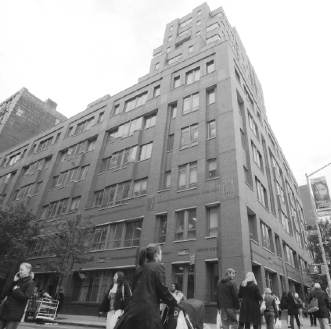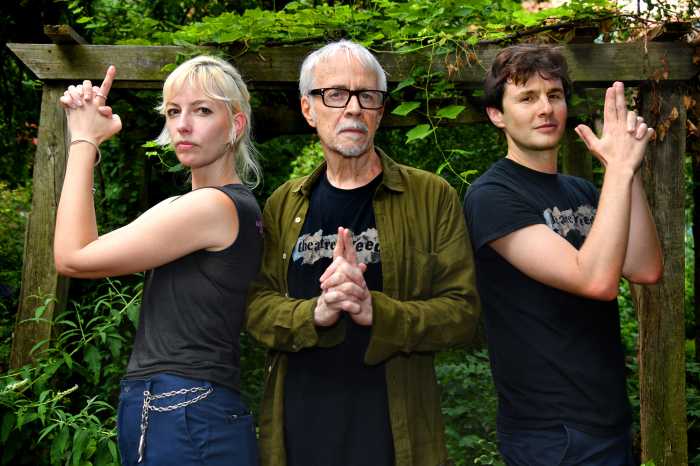By Diane Vacca
The School Construction Authority presented preliminary plans for a new School District 2 primary school week that will occupy the first six floors of the New York Foundling Hospital in the Chelsea/Flatiron area. First announced in May, the pre-kindergarten-through-fifth-grade school will have approximately 560 seats and also accommodate an undetermined number of special-education students who will come from across the city.
The Foundling Hospital will continue to own and occupy the upper stories of the 14-story building, at the southeast corner of 17th St. and Sixth Ave., and the city will acquire a condominium interest in the base of the building. The tower will house the hospital’s administrative offices and the existing Crisis Nursery, which serves homeless children in need of medical attention. The Foundling Hospital will also maintain its own entrance on Sixth Ave., while the school’s entrance will be on 17th St.
Ross Holden, S.C.A. general counsel, assured the parents that schools in mixed-use buildings are not at all unusual in New York City and function very well. He also argued that having a condominium interest is much better than leasing, because the city will own the school in perpetuity and will not ever have to renegotiate the rent. Several audience members were concerned, however, about the nature of a future occupant, should the Foundling Hospital decide to sell its part of the building. Holden assured them that the S.C.A. is executing documents to ensure that the school will not be at risk of having an unsuitable neighbor.
The Foundling Hospital still has to move to a new facility it will build in Yonkers, so the city will have no access to the property for at least three years. The S.C.A. doesn’t yet have detailed designs for the new school, but Holden said they will “be ready to go” as soon as the hospital moves out.
Peter Percudani, an S.C.A. architect, estimated construction will take an additional two years, so the new school will not be ready to open for at least five years. He said the space, unlike most existing buildings, lends itself well to a school conversion.
In Percudani’s preliminary plans, the existing garage would be used as a multipurpose room; the lower grades would occupy the lower floors; and the second-floor roof could serve as an outdoor play space. He repeated, however, that the plans are subject to change.
Holden said negotiations with the Foundling Hospital are almost finished and that it has been a “very amicable, collaborative process.” Representatives of the SCA, the hospital and developer Rudin Management — which guaranteed the deal between the hospital and the S.C.A. — all praised the synergy that culminated in the siting of the sorely needed school.
“The Foundling Hospital likes the idea of having a school in its space,” Holden said. “One of its missions is to take care of kids, and what better way to do it than to have a public school there?”
The audience was also largely enthusiastic. Irene Kaufman, one of the founding members of the Public School Parent Advocacy Committee, reminded the S.C.A. that some children at P.S. 41 are taught in hallways. She welcomed the new school as a “sensational beginning,” adding, “It’s extremely exciting.”
Kaufman worried, however, that given the many new apartment buildings in the district, “this wonderful school will be packed the day it opens, and we won’t have enough room for everyone.”
Ann Kjellberg, another founding P.S.P.A.C. member, thanked John Gilbert, Rudin C.O.O., “for their historic gesture in initiating this school.” She expressed “our hope that this will be the first of many school projects that draw on the collaboration of neighborhoods, developers and community boards.”
Kjellberg also voiced several concerns, estimating that with an enrollment of 560 and 21 classrooms planned, the school would have 27 children per class — far exceeding class-size reduction targets.
“Parents get very concerned when they see the plans are actually being designed around occupancy at a high class-size level,” she said.
Percudani replied that all figures are tentative and subject to change. Kjellberg requested that the community be more engaged in developing the school’s program and philosophy, and planning of the facilities. She also requested that the school not be called Foundling, suggesting that name could be confusing to young children.
A third founding P.S.P.A.C. member, Michael Markowitz, called the school “literally a godsend, given the crisis level of overcrowding throughout District 2.” He then requested clarification of some details, wanting to know if there is a written commitment to fund both the condominium purchase and the renovation, and whether it will appear in the S.C.A.’s 2010-’14 capital plan. He also sought assurance that in the current economic climate, money will be available “to back up all the goodwill.”
When Markowitz asked how much was being budgeted for purchase and renovation, Holden would not reveal any figures, noting that negotiations were still in progress. Markowitz said he plans to examine the draft of the capital plan very carefully, looking for a $60 million to $100 million item — his estimate of the combined cost — in the schools budget.
Finally, Markowitz returned to the issue of class size, which was brought up by every parent who spoke: “We are already sensing, quite candidly, the 560 number is a little higher than we would have calculated for the same space.”
Percudani responded that it is a ballpark figure that will likely change by the time the school is built.
Several people asked about the future of a possible school at 75 Morton St. in the West Village. One parent asked the S.C.A. to visit the site and consider using it for a school. Holden said it would require negotiations, and Percudani said all buildings must meet the seismic code, and most buildings are not suitable for schools. Markowitz asked why the city did not put in a bid when the building was on the market in August. The answer was that the building, which is owned by the state, is not for sale. However, the Empire State Development Corporation, earlier this year, in fact, had issued a request for proposals, or R.F.P., for developers for 75 Morton St. — but then taken the property off the market.
The 45-day public comment period for the Foundling school proposal began on Oct. 6, when the S.C.A. published a notice of filing. The environmental impact of the school is currently being evaluated. The public can provide comments to the S.C.A. before Nov. 20; Holden said all comments will be considered when a decision is made to move forward into the second phase. After all the comments have been received, the proposed school must be approved by the mayor and City Council. Comments may be sent to the attention of Ross J. Holden, New York City School Construction Authority, 30-30 Thomson Ave., Long Island City, N.Y., 11101.





































